As you step into your backyard, the sound of bamboo leaves and a calm stream take you to a peaceful oasis. An oriental garden is more than a space; it’s a place that delights and soothes. Imagine turning your backyard into a sanctuary of beauty and calm.
With the right steps, you can bring the elegance of Japanese and Chinese gardens to your home. This is your chance to create a space that reflects your vision and lifestyle.
Starting your oriental garden might seem hard, but it’s rewarding and fun. We’ll guide you from picking plants to adding traditional touches. You’ll learn to create a private retreat that shows off your style.
Get ready for a journey that changes how you see your home. The lines between inside and outside will fade, and you’ll be drawn into the beauty of the East. Let’s start making a peaceful oasis that will touch your soul and inspire others.
Table of Contents
Introduction to Oriental Gardens
Oriental gardens blend natural beauty, symbolic meaning, and calm. They are more than just pretty views. They show a deep respect for the environment.
What is an Oriental Garden?
Oriental gardens love the natural world. They are peaceful places that make you feel calm. You’ll see zen gardens and japanese landscaping with pagodas and bridges. Each garden shows the chinese garden design spirit.
Key Features of Oriental Gardens
- Water features like ponds and waterfalls symbolize purity and peace
- Rocks and boulders stand for nature’s strength and timelessness
- Plants are chosen for their meaning and beauty through the seasons
- Traditional buildings and lanterns add authenticity
The Philosophy Behind Oriental Gardening
Oriental gardens are made with respect for nature and a quest for balance. They follow feng shui and zen to create calm. They show the beauty of nature and invite us to slow down and connect with it.
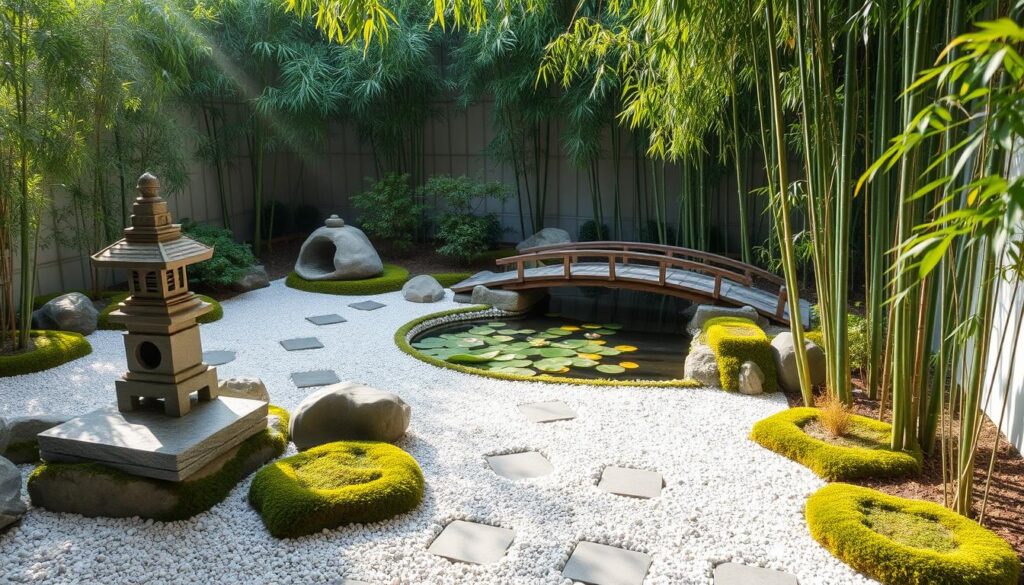
“The true art of Japanese gardening is to create a miniature stylized landscape, to represent the essence of nature.”
Choosing the Right Location
Creating an enchanting oriental garden at home starts with the right location. The perfect spot can greatly impact your garden’s beauty and health. As you plan your garden, consider the sunlight, shade, wind, and weather.
Assessing Sunlight and Shade
Look at how much sunlight and shade your yard gets each day. Plants like Japanese maples and bamboo love partial shade. Find areas that get a mix of sun and shade for a variety of plants.
Remember, the sun’s position changes with the seasons. This affects which plants you can choose and where to put them.
Considering Wind and Weather Patterns
Check your yard’s wind patterns and how they might harm plants and water features. Strong winds can damage leaves and flowers, and disturb ponds and streams. Look for sheltered spots that protect from harsh weather.
Choosing a spot that naturally shields from the elements keeps your garden peaceful. By carefully planning, your oriental garden will flourish and reflect its unique style.
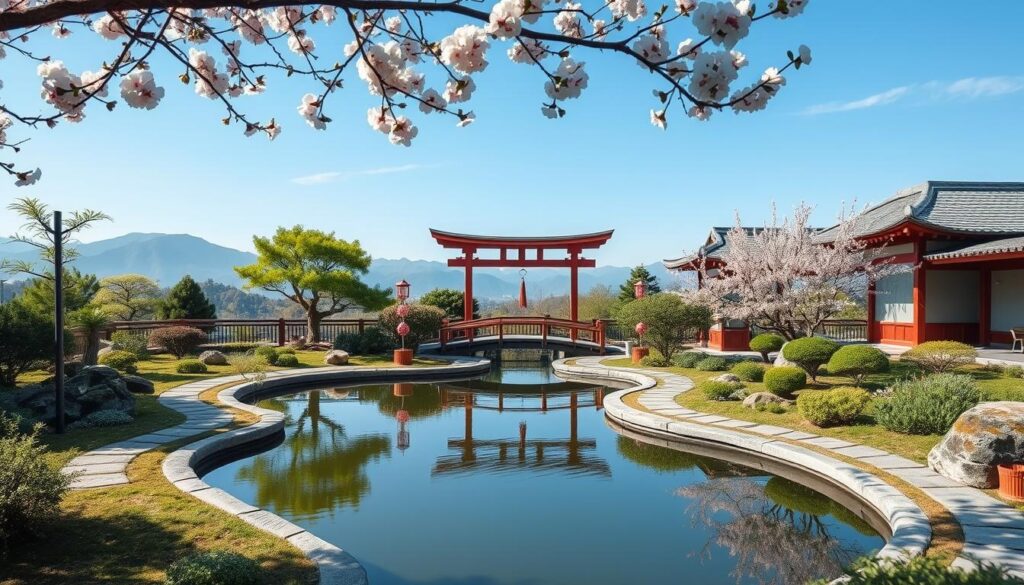
Essential Elements of an Oriental Garden
To create a real oriental garden at home, you need to add key elements. These elements bring the beauty of traditional Asian landscapes to your backyard. They include calm water features and stunning rock formations, all working together to make a peaceful and beautiful outdoor space.
Water Features: Ponds and Streams
Water features like koi ponds and streams are key in oriental gardens. They stand for purity, calmness, and the flow of life. Waterfalls can be simple or complex, adding to the garden’s beauty.
Designers use manmade peninsulas in ponds to make them look bigger. This adds harmony to the garden.
Rock Gardens and Stone Pathways
Rocks and stone pathways are crucial in an oriental garden. There are three types of rocks, each for different uses. Designers prefer rocks that are natural and asymmetrical, blending well with the garden.
Stepping stones, called Sawatobi-ishi, are placed in ponds and streams. They create paths and offer great views. Bridges, from simple to arched, symbolize entering a peaceful paradise.
Plant Selections: Trees and Shrubs
The choice of trees and shrubs in an oriental garden shows Asia’s rich gardening traditions. Plants like Japanese maples and cherry trees add timeless beauty. These asian plants complement the water and rocks, making the garden stunning.
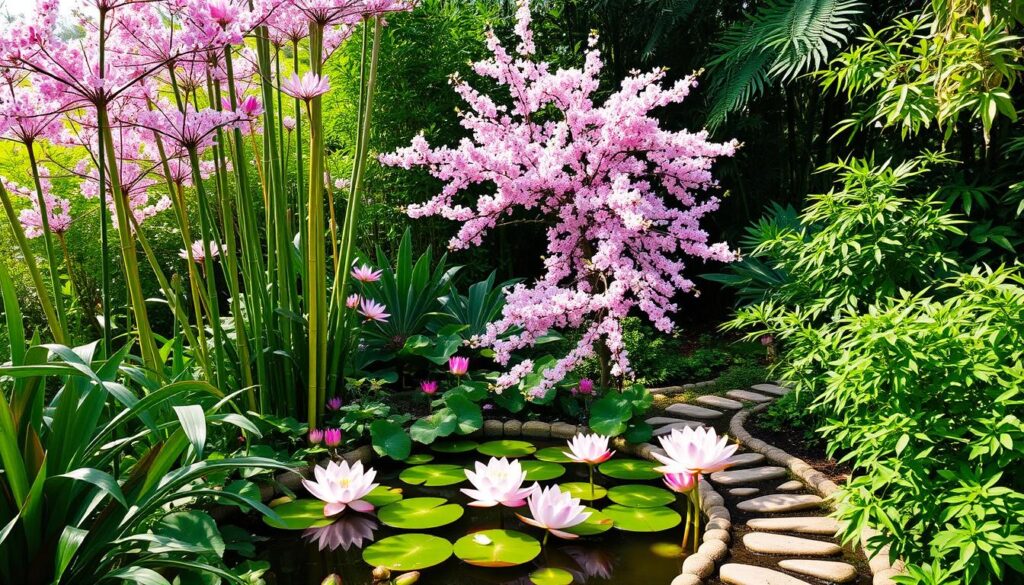
“The essence of Japanese garden design is to create a microcosm of the natural world, where every element, from the placement of stones to the shaping of trees, is carefully considered to evoke a sense of harmony and tranquility.”
By adding koi ponds, rock gardens, and the right asian plants, you can turn your backyard into a peaceful oasis. It will bring serenity and wonder to your space.
Popular Plants for Oriental Gardens
Transform your outdoor space into a serene oasis with plants that capture the essence of oriental gardens. Bamboo, cherry blossoms, and Japanese maples are key elements. They add tranquility and cultural depth to any garden.
Bamboo: Versatile and Decorative
Bamboo is a standout in oriental gardens, providing both beauty and function. Its tall canes and lush leaves create privacy and add a touch of elegance. It’s also fast-growing, perfect for screens and fences.
Bamboo’s unique features make it a focal point, enhancing your garden’s serene vibe.
Cherry Blossom Trees: A Symbol of Beauty
Cherry blossom trees are a symbol of life’s fleeting beauty in oriental gardens. Their stunning pink or white blooms signal spring’s arrival. They turn your garden into a magical oasis.
Having one or several of these trees will leave a lasting impression on all who see it.
Japanese Maples: Vibrant Foliage Options
Japanese maples add vibrant colors and intricate leaves to your garden. They come in various sizes and leaf types, offering a range of japanese maple varieties. From delicate Dissectum cultivars to bold Palmatum varieties, they provide beauty all year.
Adding azaleas, camellias, and bonsai trees enhances your garden’s beauty and meaning. A well-chosen selection of plants can create a captivating oriental oasis.
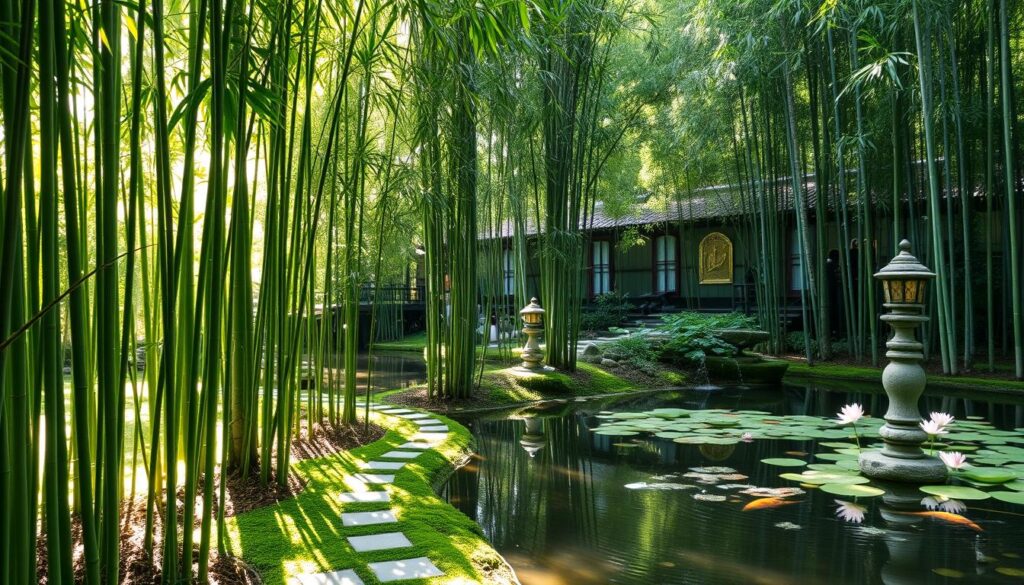
“In the world of gardens, the oriental garden stands as a harmonious symphony, where every plant, stone, and water feature plays a vital role in creating a tranquil and contemplative space.”
Designing Your Oriental Garden
Creating an authentic Oriental garden needs careful planning and design. The goal is to make your garden flow naturally, inviting visitors to explore and find new views. By using Japanese garden design elements like asymmetry and borrowed scenery, you can make a peaceful outdoor space.
Layout and Planning: Creating Flow
When planning your Oriental garden, aim for a natural flow. Steer clear of straight lines and geometric shapes. Instead, use winding paths and curved shapes. This will lead visitors through the garden, showing them new sights at every turn.
Think about Japanese garden design, like shakkei, or “borrowed scenery.” Add elements from outside, like mountains or trees, to blend your garden with nature.
Using Focal Points for Aesthetic Appeal
Focal points are key for adding beauty and depth to your garden. Features like pagodas, stone lanterns, or special rocks can catch the eye and spark curiosity.
- Pagodas or stone lanterns can be major focal points, guiding visitors and adding traditional Japanese flair.
- Asymmetrical rock arrangements can bring balance and calm.
- Water features, like ponds or waterfalls, can be stunning focal points, reflecting the landscape and creating peace.
By using these design principles, you can make an Oriental garden that shows the beauty of Japanese landscape architecture. It will also reflect your personal style and vision.
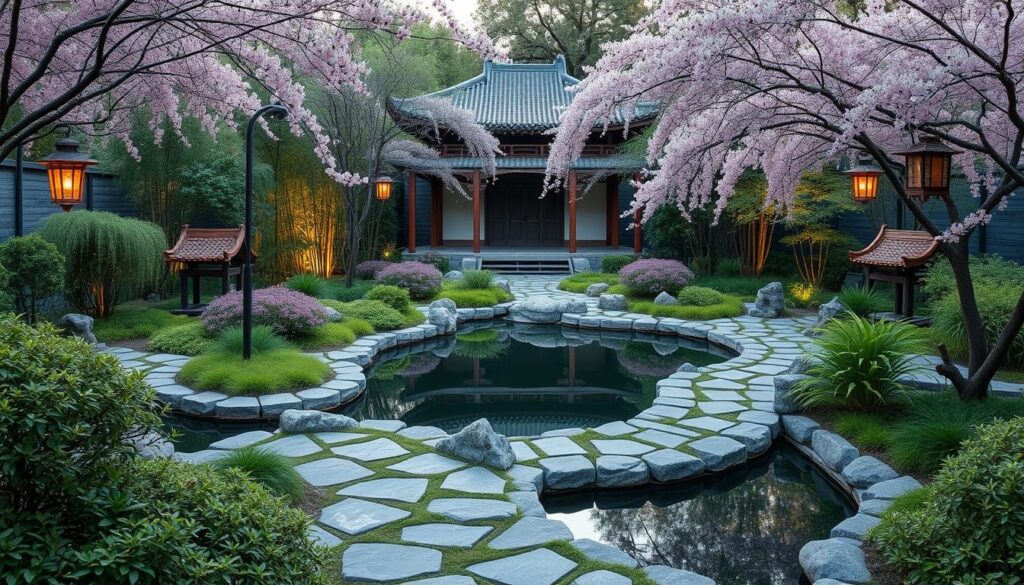
Incorporating Traditional Features
Make your garden a special place with traditional Japanese elements. Add stone lanterns along paths or by water. They light up your space and bring a real touch of Japan.
Garden bridges and arches make your garden unique. They connect different parts of your garden. Made from wood, stone, or bamboo, they fit perfectly with your garden’s Japanese feel.
Think about adding a teahouse or pavilion for quiet moments. These spots let you enjoy your garden’s views fully. They make your garden a place for peace and beauty.
“The true essence of a garden lies not just in its physical elements, but in the tranquil atmosphere it cultivates, inviting us to slow down, connect with nature, and find solace in the simple pleasures of the moment.”
With stone lanterns, garden bridges, and other Japanese touches, your garden becomes a peaceful retreat. It captures the beauty and wisdom of the East.
Maintenance Tips for Your Oriental Garden
To keep your oriental garden beautiful and balanced, follow regular care routines and pruning tips. These steps help your garden stay vibrant and inviting all year round.
Seasonal Care Routines
As seasons change, your garden needs special care. In spring, clean up, prepare beds, and use organic fertilizers. Summer calls for regular watering and pest control to keep plants healthy.
In fall, prune trees, mulch beds, and protect plants for winter. Winter means protecting sensitive plants and keeping water features looking good.
Pruning and Shaping Plants
Pruning is key to your garden’s unique look. Trees like Japanese maples and pines need regular trimming. Shaping shrubs and bushes adds to your garden’s beauty.
For the best pruning, talk to a local horticulturist. They can guide you on caring for your plants, ensuring your garden thrives.
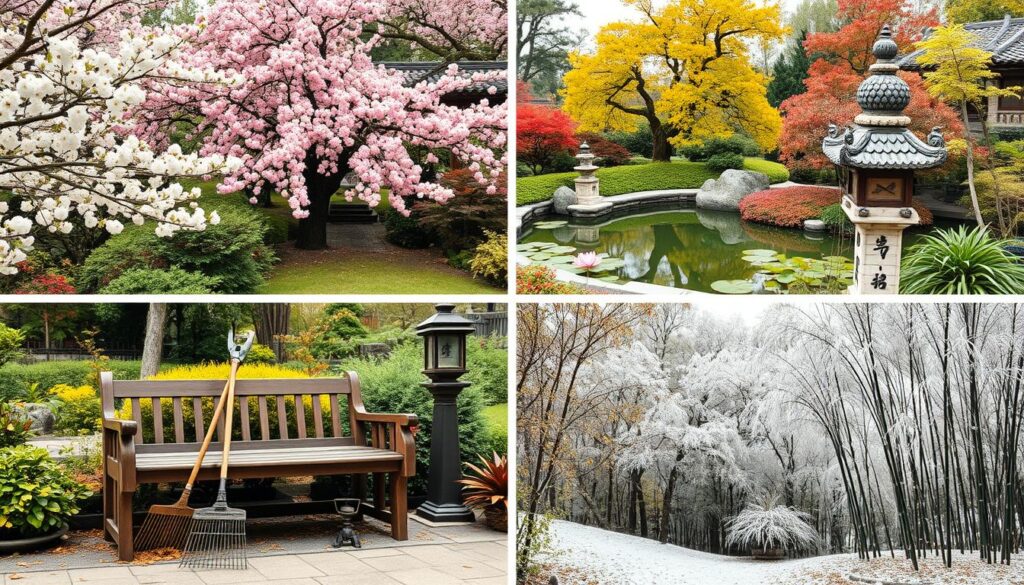
Following these maintenance tips will keep your oriental-garden stunning all year. Enjoy the peace and beauty it brings to your home for many years.
Eco-Friendly Practices for Your Garden
When designing your oriental-garden, choose eco-friendly practices. These help the environment and make your garden last longer. Focus on plants that need less water and use water wisely. This way, you’ll have a beautiful, easy-to-care-for garden that’s good for the planet.
Sustainable Plant Choices
Choose plants that are native and can handle drought well. These sustainable gardening options need less water and care. They also help local wildlife by providing food and shelter. This makes your water-wise landscaping even better for the environment.
Water Conservation Techniques
Save water in your garden with smart strategies. Use drip irrigation to water plants directly, cutting down on evaporation. Pick native plants that use less water. You can also have a dry riverbed instead of a traditional water feature. These steps help your garden stay healthy, even when it’s dry.
By carefully choosing plants and managing water, your oriental-garden can become a beautiful, eco-friendly oasis. These sustainable practices make your garden look great and help the environment too.
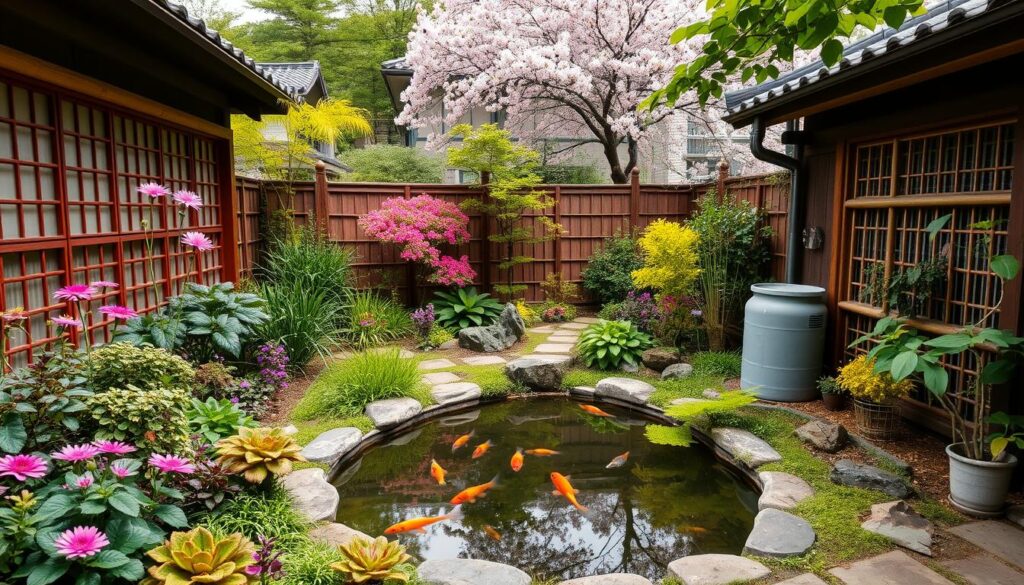
“Sustainable gardening is not just about the plants we choose, but the way we interact with the land and the resources we use.”
| Conventional Gardening | Eco-Friendly Gardening |
|---|---|
| Poor soil health, limited biodiversity, high water use, heavy fertilizer and pesticide use, high maintenance, high carbon footprint. | Enhanced soil health, diverse ecosystems, reduced water use, natural nutrient cycling, integrated pest management strategies, lower maintenance effort, low carbon footprint, and high carbon sequestration. |
Conclusion: Bringing Your Vision to Life
Creating an oriental-garden is a rewarding journey. It combines art, nature, and personal expression. Your garden should reflect your connection to nature and bring peace and inspiration to your life.
Final Thoughts on Creating Your Oriental Garden
The journey of creating an oriental-garden is about balance and harmony. By understanding the philosophy behind it, you can make a space that delights and nourishes. Let nature and your preferences guide your design choices.
Encouragement to Personalize Your Space
As you refine your oriental garden, add your own style and preferences. Personalized landscaping makes your garden truly meaningful and garden inspiration that speaks to you. Try different oriental garden design elements and let your creativity shine. This way, you’ll create a space that’s uniquely yours.
FAQ
What is an oriental-garden?
An oriental-garden comes from Japanese and Chinese traditions. It aims to blend with nature. It has water features, rocks, plants, and structures for balance and calm.
What are the key features of an oriental-garden?
Key features include ponds, rock gardens, and stone paths. Plants like bamboo and cherry blossoms are also important. These elements make the garden peaceful and balanced.
What is the philosophy behind oriental-gardening?
Oriental-gardening seeks peaceful spaces for reflection. It follows feng shui and zen aesthetics. The goal is to blend nature and design for a serene feel.
How do I choose the right location for my oriental-garden?
Choose a spot based on sunlight and shade. Consider wind and weather to protect plants. The right spot affects plant growth and the garden’s feel.
What are the essential elements of an oriental-garden?
Essential elements are ponds, rock gardens, and stone paths. Trees and shrubs like Japanese maples add to the balance. These elements create harmony in the garden.
What are some popular plant choices for oriental-gardens?
Bamboo, cherry blossoms, and Japanese maples are popular. Azaleas, camellias, and bonsai trees also add beauty and meaning. These plants enhance the garden’s look and tradition.
How do I design an oriental-garden with a natural flow and visual interest?
Use Japanese design principles like asymmetry. Add focal points like pagodas and stone lanterns. Curves and winding paths should reflect nature, not straight lines.
What traditional features can I include in my oriental-garden?
Include stone lanterns, bridges, and arches. Use wood, stone, or bamboo for these features. A teahouse or pavilion adds a place for contemplation.
How do I maintain an oriental-garden throughout the seasons?
Care for your garden changes with the seasons. Spring is for cleaning, summer for watering, fall for pruning, and winter for protection. Regular maintenance keeps the garden beautiful and functional.
How can I incorporate eco-friendly practices into my oriental-garden?
Choose sustainable plants for your garden. Use water conservation like rainwater harvesting. Consider a dry riverbed instead of a pond for less maintenance.


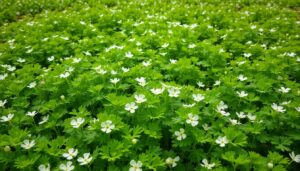

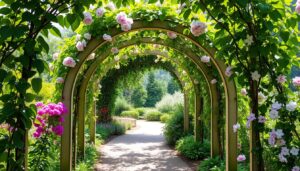

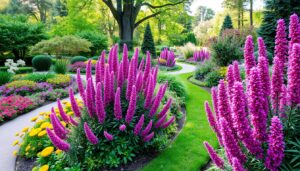

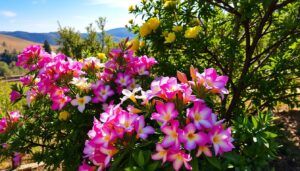
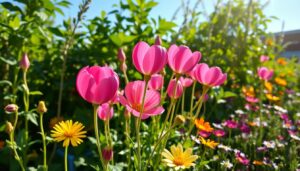
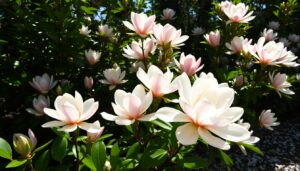
1 thought on “Create Your Dream Oriental Garden at Home Today”